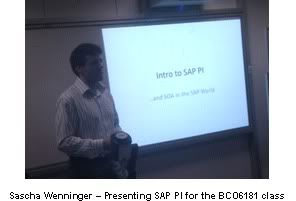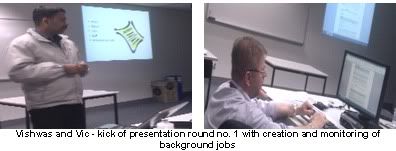Guest presenter - Sascha Wenninger - PI and SOA in SAP
Tony de Thomasis started with his standard humorous style, fielding questions relating to previous lectures and the upcoming presentation assessments. Once question time was up, Tony introduced the guest speaker for the night, Sascha Wenninger - Integration Architect - SAP Services currently at Australia Post.

Sascha’s presentation introduced us to PI and Service Oriented Architecture (SOA). Sascha explained that enterprise services enable customers to integrate their legacy applications into the PI landscape and that SAP NetWeaver PI is moving closer to SOA technology. It was also emphasized that the Enterprise Service Architecture represents a new architectural model for SAP and that it supports basic principles of Service Oriented Architecture such as:
- Messaging structures;
- Tools for creating services;
- Tools for consuming services;
- Registry and repository tools.
SAP provides the infrastructure and processes in the form of enterprise services that wrap relevant functions into a self-contained unit. Sascha also informed us that NetWeaver PI internally processes messages in a special XML format; this format is based on the SOAP (Simple Object Access Protocol) standards. SOAP XML documents comprise of message attributes, these attributes consist of message header, message body and message payloads.
To illustrate the use if PI, Sascha outlined how Australia Post is utilizing this. It was interesting to hear about the real time integration of separate Australia Post retail outlets via web-services. This was a clearly defined example of a how large enterprise is connecting their disparate systems with the main SAP ECC.
Within the one hour presentation, there was no way that we could have expected Sascha to cover SAP NetWeaver PI in its entirety, however the product was introduced to us and some of its core capabilities highlighted, providing us with an excellent starting point.
Presentations – Creating variants, scheduling and monitoring jobs

As part of assessment, tonight we received two in depth presentations that focused on transactions used in the creation and monitoring of background jobs within SAP. These were presented by students: Vishwas and Vic.
Both presentations consisted of useful background information and practical instructions, highlighting the importance of monitoring various aspects of an SAP instance. To demonstrate how jobs are scheduled and monitored, the presentations focused on a process that automates the re-scheduling of failed inbound IDoc information flows - ABAP program RBDMANI2.
Vishwas and Vic also included clear, specific instructions that covered running a program in the background (SE38), creation of a variant for the selection of IDocs according to error message and date (SE38), viewing of the created variant, definition, release, scheduling (SM36) and monitoring of a background job (SM37).
These presentations were made available to all via our Dropbox, and have since served us as valuable points of reference. The general class feedback was that these presentations gave everyone a clearer understanding of how and why such processes are useful.
